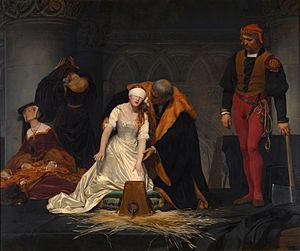Lady Jane Grey (poem) facts for kids
"Lady Jane Grey" is a long poem written by Francis Hodgson. It was published in 1809. The poem tells the sad story of Lady Jane Grey, a young woman who was briefly Queen of England.
Who Was Lady Jane Grey?
Lady Jane Grey was a great-granddaughter of King Henry VII. He was the father of the famous King Henry VIII. When Henry VIII's son, King Edward VI, died, Lady Jane was offered the crown of England.
She ruled for only nine days, which is why she is sometimes called The Nine Days Queen. Soon after, another queen, Mary I of England, took the throne. Queen Mary put Lady Jane in prison.
Lady Jane's Tragic End
Lady Jane Grey was found guilty of treason. She was sentenced to death. At just seventeen years old, she was executed in the Tower of London. Her story is a very sad part of English history.
About the Author
Francis Hodgson was an English poet. He was born in 1781. He was known as a romantic poet, meaning his poems often focused on feelings and nature. Hodgson was also a good friend of another famous poet, Lord Byron.
Besides writing his own poems, Francis Hodgson was a translator. He changed many works by ancient Roman poets into English. He passed away in 1852.
The Poem's Style
The poem "Lady Jane Grey" is written in a special style. It uses something called iambic pentameter. This means each line has a rhythm like "da-DUM da-DUM da-DUM da-DUM da-DUM." The lines are also grouped into heroic couplets, which means two lines that rhyme together. This style was very common in English poetry during the 1700s.
Through these low grounds of sorrow, toil and strife,
As runs the troubled stream of human life,
Why should the poor laborious crowd repine?
For wealth, for honour, lovely Jane were thine,
Yet my sad tale examplifies in thee,
How equal are our shares of misery
Or in the highest, or the humblest lot,
The king's proud palace, or the straw-roof'd cot.



